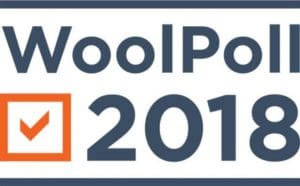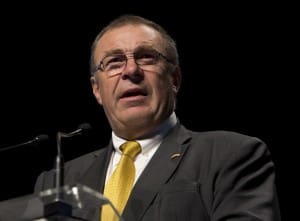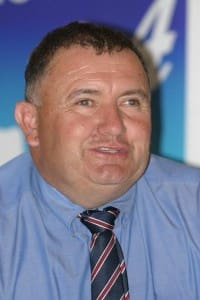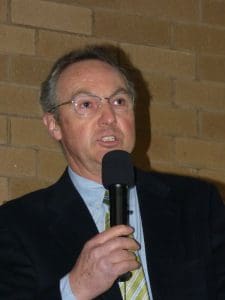 AUSTRALIAN wool growers have been urged to make their WoolPoll 2018 vote count as the industry’s research, development and marketing body seeks a 2 percent levy for another three years.
AUSTRALIAN wool growers have been urged to make their WoolPoll 2018 vote count as the industry’s research, development and marketing body seeks a 2 percent levy for another three years.
As announced by Sheep Central last Friday, Australian Wool Innovation today formally released the levy options shareholders will vote on in WoolPoll 2018 – 0 percent, 1.5pc, 2pc, 2.5pc and 3pc.
However, the levy vote options prompted criticism from peak grower body WoolProducers Australia that AWI had chosen the option range to utilise the ‘centre-stage effect’, whereby there is an inherent bias to choose the middle option.
AWI is asking growers to continue to pay a 2pc levy on their gross wool cheques, claiming in a voter information memorandum that this will build the company’s capacity to deliver more through current core R&D and marketing programs. The company also planned to draw down on its discretionary reserve to invest in a new automated wool harvesting system strategy and possibly invest in other major areas.
Retaining the 2pc levy would also allow AWI to maintain its forward contracts, operating, emergency animal and discretionary reserves at “a responsible level,” the company said.
“As 2pc is the current levy rate, by maintaining this rate, the risk level is expected to be equivalent to what we are currently managing,” AWI said.
AWI board member and WoolPoll Panel member Jock Laurie said the board is focused on building resilience within the industry, particularly through AWI’s investments, while times are good.
“We believe 2pc is the optimum level to balance our financial responsibility with our capacity to deliver benefits for growers.
“Many wool growers are taking advantage of the current good prices and investing back into their businesses – because we all know that choosing to invest when times are good enables woolgrowers to future-proof their business and build resilience,” he said.
“Similarly, AWI is committed to safeguarding against future downturns, and invest in ‘big-ticket’ activities which might otherwise not be possible.
“The levy is so critically important to enable us to collectively invest in research, development (R&D) and marketing, and therefore enabling industry to collectively benefit – from on-farm research right through to educating the consumer about the benefits of Australian wool.”
By maintaining a 2pc levy, AWI can continue to deliver our core R&D programs, invest in new projects to help lower production costs, keep marketing Australian wool and building global demand and secure wool’s place in the future apparel and textile market, Mr Laurie said.
A levy cut leaves no room to plan – AWI

AWI board member Jock Laurie
Mr Laurie said some parts of the industry say that cutting the levy won’t hurt R&D or marketing investments, because the higher wool price will counteract any losses to AWI’s funding.
“But a cut to the levy leaves no room in the budget to prepare for tomorrow – which is critical given the historically volatile and cyclical nature of wool prices.”
Mr Laurie said whether wool was the primary focus of a shareholder’s business, part of a mixed enterprise, or just a hobby on the side, “your vote counts”.
“Don’t leave it to others to decide what investment – if any – is made in future R&D and marketing for our industry.”
WoolPoll 2018 panel chairman Sid Laurie said at a time when wool prices are on a sustained high, it’s never been a more important time for growers to have their say on the levy rate for the next three years.
“Wool is the only industry where the levy payers get to have a say every three years on how much we want to invest in wool research, development and marketing.
“It’s such a critical vote and every eligible grower should have their say.”
After three years at a 1.5pc levy rate the company said its discretionary reserves would be below the optimum level, estimated at $80 million, and at six years would be below its required wind-up reserves, AWI said in the VIM. It said a 1.5pc levy would leave it highly exposed to wool price fluctuations and would mean AWI will have to limit activities. A zero vote and no levy income would cause a wind-up of existing R&D and marketing programs and sale of company assets, AWI said.
However, with a 2.5pc or 3pc levy, AWI would look to accelerate and expand programs, and retain reserves at a healthy level.
AWI not listening to growers – WPA

WoolProducers president Richard Halliday
WPA president Richard Halliday said despite AWI’s claims, “the AWI board (members) have not listened to growers, and have put forward option rates to pursue their own interests – this is unacceptable.”
WPA said it is inappropriate the body receiving the compulsory levy is the only one that decides the options for shareholders, while also being able to lobby for a particular option during the WoolPoll process.
Under the Wool Levy Poll Regulations that WoolPoll is conducted under, 0pc must be included as an option. Given the current high wool prices currently being received, decreasing the levy rate will be a serious consideration for many growers, WPA said.
“It is illogical in the current environment to only provide wool growers with the opportunity to reduce the levy rate by half a percent or cease it all together, but to then provide two options above status quo,” Mr Halliday said.
Mr Halliday said the inclusion of two options above the current levy rate of 2pc makes no sense given the total combined percentage of votes in the 2012 and 2015 WoolPolls for 2.5pc and 3pc levy rate options did not exceed 7pc.
“WPA made this point in a letter to the WoolPoll panel chair, Sid Laurie, when we were approached to provide our preferred levy rate options earlier in the year.”
WPA put forward 0pc, 1pc, 1.5pc, 2pc and 2.5pc as the preferred levy rate range, as these would have provided wool growers with a range of incremental levy options to consider, the body said.
AWI assumptions understate EMI
AWI’s levy rate modelling for the next WoolPoll period of 2019/20 to 2021/22 has assumed a forward wool price benchmark of EMI of 1700c/kg as the 2017/18 season average, although the voter information memorandum also quotes the 2017/18 EMI average as being 1734c/kg clean and reaching a record high of 2073c/kg. Both averages are more than 380 cents below the current EMI of 2116 cents. The average so far in 2018/19 is 2012c/kg. The average EMI in 2016/17 was 1401c/kg.
AWGA says AWI needs only 1.5pc

AWGA director Martin Oppenheimer
Australian Wool Growers Association director, AWI industry consultative committee member Martin Oppenheimer played a key role in developing AWGA’s policy for Woolpoll and believed AWI was deliberately understating the EMI going forward to justify its budget figures supporting a 2pc levy.
“The new wool levy doesn’t come into effect until 1 July 2019 – we’re looking at an EMI which is going to be tracking above 2100 cents.
“If that’s the case, they only need 1.5pc.”
AWGA said it is expected that, due to the drought, wool supply will decrease marginally in the next three years, but the clip will get finer.
“With those two factors acting on the market, the EMI will go even higher, giving a higher levy income despite the reduced production,” Mr Oppenheimer said.
The Australian Wool Production Forecasting Committee last week said AWTA test data for 2017/18 by micron showed reductions in weight of wool tested between 19.6 and 24.5 micron (down 11.3pc), while there was an increase in weight of wool tested between 16.6 and 19.5 micron (+11.7pc) as well as over 26.6 micron (+11.7pc). Production of wool 16.5 micron and finer fell by 10pc last season.
AWI’s WoolPoll budget has assumed an annual wool production of 352 million kilograms for 2019/20, with a 2pc annual increase, although the AWPFC’s updated forecast of shorn wool production for 2018/19 is 322mkg greasy. AWI is also budgeting for expenditure of $110 million to drive demand and support industry growth, sustainability and production. The company is forecasting closing reserves of $105.3 million at June 2019. However, there is no mention in the VIM of the impact of a finer clip on the levy income or what the 2017/18 levy income was. AWI’s total income/expenditure figures for 2017/18 are forecast to be $97m/$88m and for 2018/19 $100m/$110m.
WoolPoll voters need a matching strategic plan – AWGA
AWGA believe there should have been a strategic plan with shareholder endorsement of the investment needed, generating a preferred levy rate for WoolPoll.
“How can you set a levy rate when you don’t have a strategic plan.
“How can they put this ($110m) sum up without a strategic plan that has been considered by shareholders?” Mr Oppenheimer said.
AWGA believe that as soon as levy income goes 10pc above forecast then monies should be diverted into a trust fund or levies cease to be paid.
AWGA is preparing a WoolPoll ready reckoner, a levy saving quick calculator and a rate calculator, for growers to analyse AWI’s assumptions, and calculate what their levy payment might be under various rates, depending on their annual wool production and bale value average.
Growers urged to vote preferentially
Mr Oppenheimer said AWGA did not care whether shareholders voted zero or 1.5pc, but he urged them to utilise the WoolPoll’s preferential voting system to ensure their intentions were fully reflected in the end result. The total combined percentage of votes in the 2012 and 2015 WoolPolls for 2.5pc and 3pc levy rate options did not exceed 7pc (6.95pc in 2012 and 6.69pc in 2015). The vote for 2pc in 2015 was 61.17pc and 53.39pc in 2012. The vote for 1pc or less in 2015 was 32.13pc and in 2012 was 39.65pc, highlighting why the AWI board this year disallowed a 1pc option despite grower body wishes.
“If you vote for only one option, other than 1.5pc or 2pc, at some time your vote might become void, because votes will become preferentially distributed until there are just two piles – and the pile with the most votes wins.”
On the WoolPoll ballot paper, shareholders can place the number 1 in the box of their first preference, but they can also complete their paper by placing numbers in the remaining four boxes in order of their preferences, ie 2, 3, 4 and 5, with 5 being their last preference.
Votes in WoolPoll 2018 will be counted using an optional preferential voting system to ensure that the outcome satisfies the greatest number of levy payers. This means that, if none of the five levy rates achieves 50pc or more first preference votes, levy payers who voted for the least preferred option will have their votes allocated to their second preferences. Reallocating preferences continues until one of the levy rates reaches a majority of votes counted.
Anyone who has paid at least $100 worth of wool levies over the past three years is eligible to vote when WoolPoll opens on Monday, 17 September. Voting closes on Friday, 2 November.
Growers will start to receive information about WoolPoll over the next few weeks, including their voting entitlement letter.
Click here to read the WoolPoll 2018 Voter Information Memorandum.

Mr Laurie, you have said, and I quote “it’s never been a more important time for growers to have their say on the levy rate for the next three years”. Yet, you won’t give us the opportunity to vote on our desired levy.
The desired levies are : 0%, 0.5%, 1%, 1.5%, and 2%.
Is it possible for you to be totally impartial and present these options?
I realise AWI’s desired levies are 0%, 1.5%, 2%, 2.5%, and 3%; however, AWI is not voting. So why is AWI setting the levies to vote on?